Related Research Articles
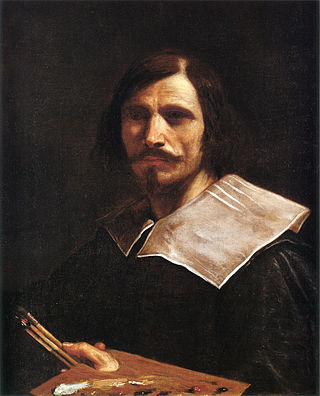
Giovanni Francesco Barbieri, better known as (il) Guercino, was an Italian Baroque painter and draftsman from Cento in the Emilia region, who was active in Rome and Bologna. The vigorous naturalism of his early manner contrasts with the classical equilibrium of his later works. His many drawings are noted for their luminosity and lively style.

Annibale Carracci was an Italian painter and instructor, active in Bologna and later in Rome. Along with his brother and cousin, Annibale was one of the progenitors, if not founders of a leading strand of the Baroque style, borrowing from styles from both north and south of their native city, and aspiring for a return to classical monumentality, but adding a more vital dynamism. Painters working under Annibale at the gallery of the Palazzo Farnese would be highly influential in Roman painting for decades.

Giovanni Battista Tiepolo, also known as GiambattistaTiepolo, was an Italian painter and printmaker from the Republic of Venice who painted in the Rococo style, considered an important member of the 18th-century Venetian school. He was prolific, and worked not only in Italy, but also in Germany and Spain.

Giovanni di Niccolò de Luteri, better known as Dosso Dossi, was an Italian Renaissance painter who belonged to the School of Ferrara, painting in a style mainly influenced by Venetian painting, in particular Giorgione and early Titian.

Giovanni Battista Moroni was an Italian painter of the Mannerism. He also is called Giambattista Moroni. Best known for his elegantly realistic portraits of the local nobility and clergy, he is considered one of the great portrait painters of the Cinquecento.
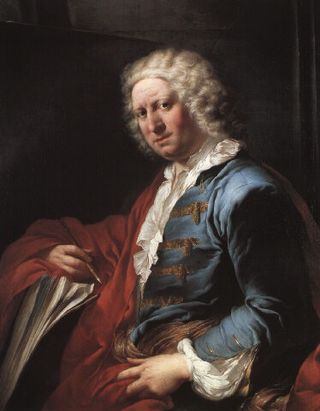
Giovanni Paolo, also known as Gian Paolo Panini or Pannini, was an Italian painter and architect who worked in Rome and is primarily known as one of the vedutisti. As a painter, Panini is best known for his vistas of Rome, in which he took a particular interest in the city's antiquities. Among his most famous works are his view of the interior of the Pantheon, and his vedute—paintings of picture galleries containing views of Rome. Most of his works, especially those of ruins, have a fanciful and unreal embellishment characteristic of capriccio themes. In this they resemble the capricci of Marco Ricci. Panini also painted portraits, including one of Pope Benedict XIV.
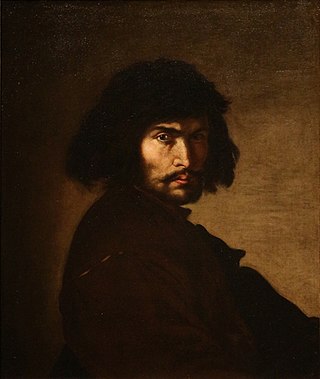
Salvator Rosa (1615–1673) is best known today as an Italian Baroque painter, whose romanticized landscapes and history paintings, often set in dark and untamed nature, exerted considerable influence from the 17th century into the early 19th century. In his lifetime he was among the most famous painters, known for his flamboyant personality, and regarded as an accomplished poet, satirist, actor, musician, and printmaker, as well. He was active in Naples, Rome, and Florence, where on occasion he was compelled to move between cities, as his caustic satire earned him enemies in the artistic and intellectual circles of the day.

Pietro Perugino, an Italian Renaissance painter of the Umbrian school, developed some of the qualities that found classic expression in the High Renaissance. Raphael became his most famous pupil.
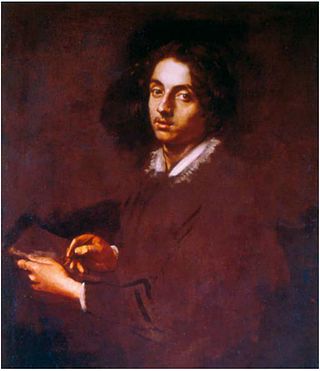
Simone Cantarini or Simone da Pesaro, called il Pesarese was an Italian painter and etcher. He is known mainly for his history paintings and portraits executed in an original style, which united aspects of Bolognese classicism with a bold naturalism.

Giovanni Fattori was an Italian artist, one of the leaders of the group known as the Macchiaioli. He was initially a painter of historical themes and military subjects. In his middle years, inspired by the Barbizon school, he became one of the leading Italian plein-airists, painting landscapes, rural scenes, and scenes of military life. After 1884, he devoted much energy to etching.
Justus Sustermans, Joost Sustermans or Suttermans, his given name Italianised to Giusto, was a Flemish painter and draughtsman who is mainly known for his portraits. He also painted history and genre paintings, still lifes and animals.

Michele Marieschi or Michele Giovanni Marieschi, also Michiel, also known as Michiel, was an Italian painter and engraver. He is mainly known for his landscapes and cityscapes (vedute), or views, mostly of Venice. He also created architectural paintings, which reveal his interest in stage design.
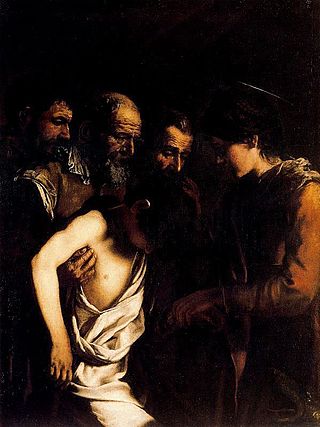
Giovanni Serodine was a Swiss-Italian painter of the early Baroque period.
Events from the year 1603 in art.

Leandro Bassano, also called Leandro dal Ponte, was an Italian artist from Bassano del Grappa who was awarded a knighthood by the Doge of Venice. He was the younger brother of artist Francesco Bassano the Younger and third son of artist Jacopo Bassano. Their father took his surname from their town of Bassano del Grappa, and trained his sons as painters.
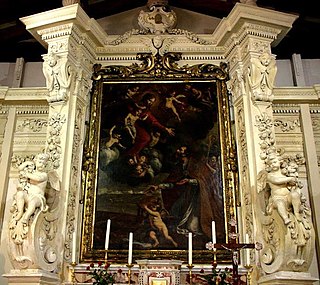
Giovanni Quagliata (1603–1673) was an Italian painter of the Baroque period. He is more properly known in Italy as Giovan Battista Quagliata, one of the leading artists of the Messinesi painters of the 17th century, as described by Francesco Susinno in his book "The Lives of the Messinesi Painters" published in 1724. Giovanni was born in Messina, Italy. He was a pupil of Pietro da Cortona and enjoyed the patronage and friendship of the Spanish Viceroy of Sicily, Don Juan José of Austria. Giovanni's brother, Andrea Quagliata, was also an historical painter, but of lesser significance. Giovanni's works – paintings, frescoes and large canvases – were famously displayed in the galleries and churches of Messina, but due to earthquakes from Mount Etna and wartime bombings, few have survived to the present day.

Carlo Magini (1720–1806) was an Italian painter of the late-Baroque period and one of the most original of the 18th century Italian still life artists.

Domenico Robusti, also known as Domenico Tintoretto, was an Italian painter from Venice. He grew up under the tutelage of his father, the renowned painter Jacopo Tintoretto.

Giovanni Francesco Guerrieri (1589–1655) was an Italian painter and Caravaggisto.
References
- ↑ Dizionario degli Artisti Italiani Viventi: pittori, scultori, e Architetti, by Angelo de Gubernatis. Tipe dei Successori Le Monnier, 1889, Page 376.
- ↑ Fano Archived 2011-05-30 at the Wayback Machine historical figures.